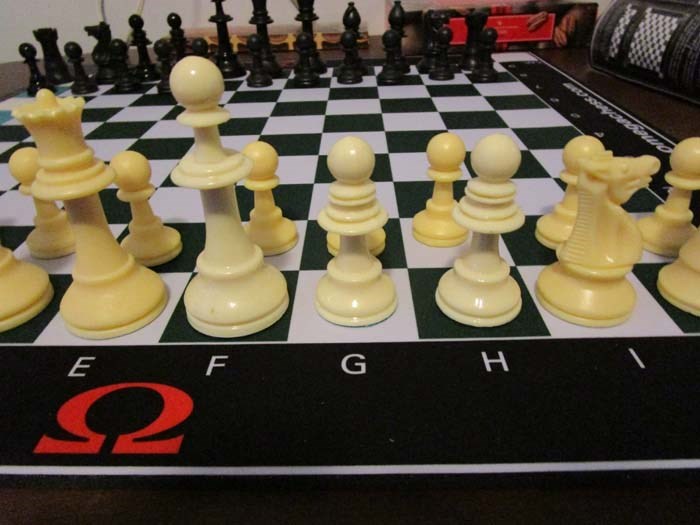As promised last week, this time around the game of the week is Wildebeest Chess.
Wildebeest Chess is a chess variant created by R. Wayne Schmittberger in 1987.
While now three decades old, this is still very much a game in the realm of a modern variant in terms of chess, and frankly one I think deserves far more attention. In fact, I rate this one on par with Omega Chess and Grand Chess, which I generally consider the best of modern variants.
The Wildebeest board is 11×10 squares. This is one of the interesting features of this variant, as the board size is one rarely used. But therein also lies a challenge for anyone wanting to play the game, finding an 11X10 board.
In my case I created an extra strip that I can lie nicely on my 10X10 Omega Chess board. It is base of ‘bristol board’ and has duct tape on the back to give it some wear and tear ability. It works quite nicely and rolls with the board to store in the Omega Chess tube.
Besides the standard chess pieces, each side has two camels and one wildebeest. The inventor’s intent was apparently to balance the number of ‘riders’—pieces that move along open lines—with the number of ‘leapers’—pieces that jump. With Wildebeest Chess each side has two knights, two camels, and a wildebeest which leap in balance with two rooks, two bishops, and a queen, which slide.
So the kings, queens, rooks, knights, bishops, and pawns move as in orthodox chess, with the following modifications. Castling is with the same restrictions as in orthodox chess - but the king may move one, two, three, or four squares in the direction of the rook; the rook jumps over the king to the next free square. Pawns may move one, two, or three squares when on the second row, and one or two squares when on the third row. On all passed squares, the pawn can be taken en-passant. Pawns promote only to queens or wildebeests.
The added pawn movement is certainly interesting, and is clearly in response to the larger board. The ability to still move an extra square on a future move, if you only took a single square with the pawn to start is certainly a rarely seen option.
Now for the more unusual pieces.
A camel has a kind of extended knight jump: it goes one square in one direction and three, not two, in the other. It is not a new piece by any stretch being part of the array of Tamerlane Chess with dates back to the late 1300s.
And the one-three leaper shows up in other games including Omega Chess where the ‘Wizard’ has the same movement, albeit with a one-step diagonal move option.
What the camel does is add some length of attack in what is already the familiar pattern of a knight.
A wildebeest, I have no idea why it is called a wildebeest, has the combined moves of a camel and knight.
The new pieces do create a second challenge, finding pieces. One option is to use pieces from a different chess set which are easily identifiable on the board.
Or you can get a bit creative, buy a set at a yard sale, grab a small saw, a sharp knife, and some glue and fashion a few alterative pieces which you can then use in a variety of variants, which was how I wiled away some holiday hours in December.
The game is quite dramatic in the sense five pieces a side can jump over pieces to attack, creating a situation where a defence is usually only effective if another piece is protecting, so that an attacker faces a trade situation.
The final interesting element of wildebeest chess is the initial array. The two bishops sit side-by-side on a player’s left, situated between the knight and queen.
On a player’s right, the camels too sit side-by-side between the knight and wildebeest, that sits right of the king.
The first thing the lay out does is it creates a very different ‘feel’ for how to use the bishops as they are on a single side of the board.
The leapers, with the exception of a single knight, start on a player’s right, and again this creates quite a new chess play experience.
If you have visualized the set up you will also have noted the two sides are not a direct mirror, with the bishops of one side sitting opposite the camels of the other, and the queen and wildebeest also facing each other. This two creates some interest in how best to attack and defend given that the sides do not mirror each other.
Overall, Wildebeest Chess has much to offer, and is definitely worth the effort to fashion a play set.
Next time, a look at Shako (chess).




